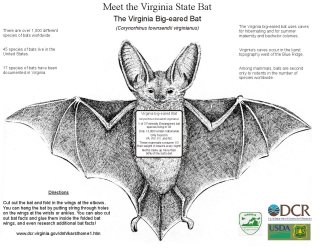
 Department of Conservation and Recreation
Department of Conservation and Recreation
Conserve. Protect. Enjoy.
 Department of Conservation and Recreation
Department of Conservation and Recreation
In the 2005 General Assembly, a rare and unique bill arose - a proposal for adopting a state bat. The Virginia Big-eared bat was recommended based on its name and status as a federally endangered species. Governor Mark Warner signed the legislation, making Virginia only the second state (after Texas) to adopt a state bat. Only 10,000 Virginia Big-eared bats remain nationwide.
The Virginia Big-eared bat is about 4 inches long, weighs less than half an ounce, and feeds mainly on moths. These mammals consume 1/3 their weight in insects every night! The large ears, which it can fold tightly against its head, are this bat's most conspicuous feature.
Habitat -
This bat lives exclusively in limestone caves with only a few isolated populations occurring in western Virginia, West Virginia, Kentucky, and North Carolina. The Virginia big-eared bat uses caves for hibernating in the winter and for summer maternity and bachelor colonies. Human disturbance of these hibernacula and maternity colonies is the biggest threat to the species. Most of Virginia's caves occur in the karst topography west of the Blue Ridge Mountains.
Offspring -
Female Virginia Big-eared bats separate into maternity colonies during the summer months, typically giving birth to one pup during June. The young pup grows rapidly and they can fly within 3 weeks of birth. The young bats are typically weaned, nearly full grown, and feeding on their own at about seven to eight weeks.
Virginia Adopts "State Bat"
www.dcr.virginia.gov/natural_heritage/documents/vacaveownersnewslettersep05.pdf

|
NatureServe explorer; enter Corynorhinus townsendii virginianus in the search box, and under the Classification tab turn on the 'include subspecies, varieties and populations.

